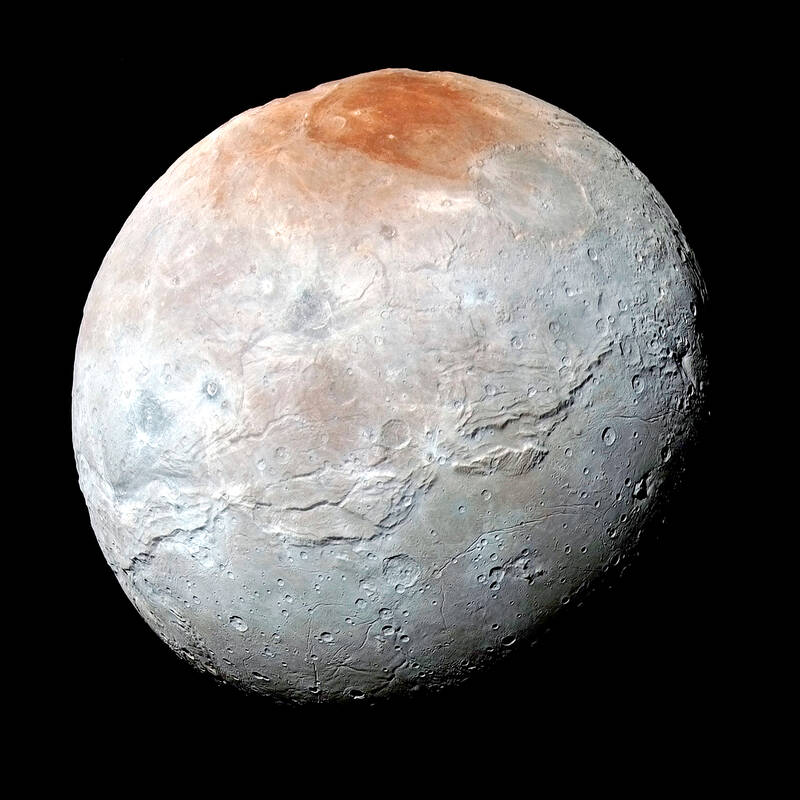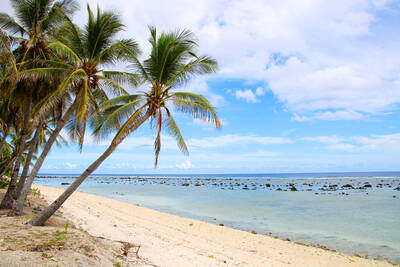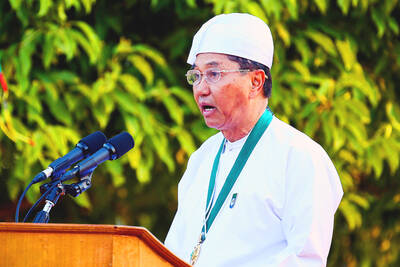Observations by the James Webb Space Telescope are giving scientists a fuller understanding about the composition of Pluto’s largest moon, Charon.
Webb for the first time detected carbon dioxide and hydrogen peroxide — both frozen as solids — on the surface of Charon, a spherical body about 1,200km in diameter, researchers said on Tuesday.
Those are added to the water ice, ammonia-bearing compounds and organic materials previously documented on the surface of Charon.

Photo: Reuters
Charon, discovered in 1978, has the distinction of being the solar system’s largest moon relative in size to the body it orbits. It is about half the diameter and one-eighth the mass of Pluto, a dwarf planet that resides in a frigid region of the outer solar system called the Kuiper Belt, beyond the most distant planet, Neptune.
The distance between Charon and Pluto is about 19,640km, compared with 384,400km on average separating Earth from its moon.
Most of Charon’s surface is gray, with reddish-brown regions around its poles composed of organic materials.
The Webb observations build on data obtained when NASA’s New Horizons spacecraft flew by Charon during its visit to the Pluto system in 2015. The new study tapped into the ability of Webb, which was launched in 2021 and began collecting data the following year, to observe across a greater range of wavelengths than previously available.
The presence of hydrogen peroxide speaks to the irradiation processes Charon has experienced, the researchers said, while the carbon dioxide is probably an original component dating to this moon’s formation.
The hydrogen peroxide formed as the water ice on the surface of Charon was chemically altered by the perpetual onslaught of ultraviolet radiation from the sun, as well as energetic particles from the solar wind and from galactic cosmic rays that traverse the universe, the researchers said.
The carbon dioxide observed by Webb was probably buried underneath the surface and exposed by impacts on Charon, they said.
The carbon dioxide is likely to have been part of the primordial material from which Charon and Pluto originally formed, they added.
Scientists had been surprised that carbon dioxide was not previously spotted.
“The detection of carbon dioxide was a satisfying confirmation of our expectations,” said Silvia Protopapa, assistant director of the department of space studies at the Southwest Research Institute in Boulder, Colorado, coinvestigator of the New Horizons mission and lead author of the study published in the journal Nature Communications.
“The detection of hydrogen peroxide on Charon was unexpected. I honestly did not anticipate finding evidence of it on the surface,” Protopapa said.
The new observations of Charon help tell a broader story about the celestial bodies populating our solar system.
“Every small body in the outer solar system is a unique piece of a larger puzzle that scientists are trying to put together,” Protopapa said.
The researchers used a Webb instrument called the Near-Infrared Spectrograph to make four observations in 2022 and last year, getting full coverage of Charon’s northern hemisphere.
“These new Webb observations add carbon dioxide and hydrogen peroxide to the known inventory of [Charon’s] surface components. Both of these provide insights into ongoing processes of irradiation and impact-driven resurfacing,” said study coauthor Ian Wong, staff scientist at the Space Telescope Science Institute in Baltimore, Maryland.

Nauru has started selling passports to fund climate action, but is so far struggling to attract new citizens to the low-lying, largely barren island in the Pacific Ocean. Nauru, one of the world’s smallest nations, has a novel plan to fund its fight against climate change by selling so-called “Golden Passports.” Selling for US$105,000 each, Nauru plans to drum up more than US$5 million in the first year of the “climate resilience citizenship” program. Almost six months after the scheme opened in February, Nauru has so far approved just six applications — covering two families and four individuals. Despite the slow start —

MOGAMI-CLASS FRIGATES: The deal is a ‘big step toward elevating national security cooperation with Australia, which is our special strategic partner,’ a Japanese official said Australia is to upgrade its navy with 11 Mogami-class frigates built by Japan’s Mitsubishi Heavy Industries, Australian Minister for Defence Richard Marles said yesterday. Billed as Japan’s biggest defense export deal since World War II, Australia is to pay US$6 billion over the next 10 years to acquire the fleet of stealth frigates. Australia is in the midst of a major military restructure, bolstering its navy with long-range firepower in an effort to deter China. It is striving to expand its fleet of major warships from 11 to 26 over the next decade. “This is clearly the biggest defense-industry agreement that has ever

DEADLY TASTE TEST: Erin Patterson tried to kill her estranged husband three times, police said in one of the major claims not heard during her initial trial Australia’s recently convicted mushroom murderer also tried to poison her husband with bolognese pasta and chicken korma curry, according to testimony aired yesterday after a suppression order lapsed. Home cook Erin Patterson was found guilty last month of murdering her husband’s parents and elderly aunt in 2023, lacing their beef Wellington lunch with lethal death cap mushrooms. A series of potentially damning allegations about Patterson’s behavior in the lead-up to the meal were withheld from the jury to give the mother-of-two a fair trial. Supreme Court Justice Christopher Beale yesterday rejected an application to keep these allegations secret. Patterson tried to kill her

MILITARY’S MAN: Myint Swe was diagnosed with neurological disorders and peripheral neuropathy disease, and had authorized another to perform his duties Myint Swe, who became Myanmar’s acting president under controversial circumstances after the military seized power from the elected government of Aung San Suu Kyi more than four years ago, died yesterday, the military said. He was 74. He died at a military hospital in the capital, Naypyidaw, in the morning, Myanmar’s military information office said in a statement. Myint Swe’s death came more than a year after he stopped carrying out his presidential duties after he was publicly reported to be ailing. His funeral is to be held at the state level, but the date had not been disclosed, a separate statement from the